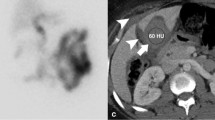Abstract
Objective
To determine the efficacy of morphine enhanced radionuclide cholescintigraphy (MC) in the diagnosis of acute cholecystitis (AC) in critically ill patients.
Design
Retrospective chart review.
Setting
2 university hospitals
Patients and methods
Records of all ICU patients who underwent MC as part of an evaluation for AC over an 8 year period were reviewed (n=45). All patients initially had standard radionuclide cholescintigraphy (RC) performed which showed nonvisualization of the gallbladder (GB) and were then given morphine sulfate (0.05–0.1 mg/kg iV).
Results
The mean age was 54 years (range 18–84 years). Risk factors for AC included fasting in 41 patients (mean 12.4 days) and total parenteral nutrition in 32 patients. Signs of biliary sepsis included temperature >100°F in 38 patients, WBC>10 000/ml3 in 40 patients, abdominal pain in 29 patients, and abnormal liver fuction tests in 42 patients. 23 patients had GB ultrasonography, with 7 showing stones. MC was positive (non-visualization) in 16 patients and negative (GB visualized) in 29, including 4 with gallstones. All patients in whom the GB was visualized did so within 1h. There were 13 patients with positive MC who underwent operation; 12 had AC (9 acalculous, 3 calculous). Three patients were treated medically and recovered (false positive). All 29 patients with negative MC were true negatives. Overall, MC had an accuracy of 91%, sensitivity of 100%, specificity of 88%, positive predictive value of 75%, and negative predictive value of 100%.
Conclusion
MC is a useful test in the evaluation of critically ill patients for suspected AC, particularly in patients with known risk factors or documented gallstones.
Similar content being viewed by others
References
Winegarner FG, Jackson GF (1971) Posttraumatic acalculous cholecustitis: a highly lethal complication. J Trauma 11:567–569
Long TN, Heimback DM, Carrico CJ (1978) Acalculous cholecystitis in critically ill patients. Am J Surg 136:31–36
Orlando R, Gleason E, Drezner AD (1983) Acute acalculous cholecystitis in the critically ill patient. Am J Surg 145:472–476
Flancbaum L, Majerus TC, Cox EF (1985) Acute post traumatic acalculous cholecystitis. Am J Surg 150:252–256
Fabian TC, Hickerson WL, Mangiante EC (1986) Posttraumatic and postoperative acute cholecystitis. Am Surg 52:188–192
Wilton PB, Delaney JP (1987) Acute acalculous cholecystitis in the intensive care unit. Surgical Rounds 10:30–46
Peterson SR, Sheldon GF (1979) Acute acalculous cholecystitis: a complication of hyperalimentation. Am J surg 138:814–817
Doty JE, Pitt HA, Porter-Fink V, DenBesten L (1984) The effect of intravenous fat and total parenteral nutrition on biliay physiology. J Parenter Enter Nutr 8:263–268
Laing FC (1963) Diagnostic evaluation of patients with suspected acute cholecystitis. Radiol Clin North Am 21: 477–493
Susarez CA, Block F, Bernstein D, Serafini A et al (1980) Role of HIDA/PIPDIA scanning in diagnosing cystic duct obstruction. Ann Surg 191: 391–396
Weissman HS, Frank MS, Berstein LH, Freeman LM (1979) Rapid and accurate diagnosis of acute cholecystitis with Tc-99m-HIDA cholescintigraphy. AJR 132:523–528
Szlabick RE, Catoo JE, Fink-Bennett D, Ventura V (1980) Hepatobiliary scanning in the diagnosis of acute cholecystitis. Arch Surg 115:540–544
Kalfe V, Forelich JW, Lloyd R, Thrall JH (1993) Predictive value of an abnormal hepatobiliary scan in patients with severe intercurrent illness. Radiology 146:191–194
Garner WL, Marx MV, Fabri PJ (1988) Cholescintigraphy in the critically ill. Am J Surg 155:727–729
Shuman WP, Gibbs P, Rudd TG, Mack LA (1982) PIPIDA scintigraphy for cholecystitis: false positives in alcoholism and total parenteral nutrition. AJR 138:1–5
Warner BW, Hamilton FW, Sibserstein EB et al (1987) The value of hepatobiliary scans in fasted patients receiving total parenteral nutrition. Surgery 102:595–600
Choy D, Shi E, Mclean RG et al (1984) Cholescintigraphy in acute cholecystitis: use of intravenous morphine. Radiology 151:203–207
Flancbaum L, Alden SM, Trooskin SZ (1989) Use of cholescintigraphy with morphine in critically ill patients with suspected cholecystitis. Surgery 106:668–674
Flancbaum L, Alden SM (1990) Morphine cholescintigraphy. Surg Gynecol Obstet 171:227–232
Flancbaum L, Wilson GA, Choban PS: Morphine cholescintigraphy in hospitalized patients: the significance of a positive result. Surg Gynecol Obstet (in press)
Shuman WP, Mack LA, Rudd TG et al (1982) Evaluation of acute right upper quadrant pain: sonography and Tc-99m-PIPIDA cholescintigraphy. AJR 139:61–64
Weissman HS, Sugarman LA, Badia JD, Freeman LM (1980) Improving the specificity and accuracy of Tc-99m-IDA cholescintigraphy with delayed views. (Abstr) J Nucl Med 21:17
Murphy P, Salomon J, Roseman D (1980) Narcotic anesthetic drugs and their effect of biliary dynamics. Arch Surg 115:710–711
Author information
Authors and Affiliations
Rights and permissions
About this article
Cite this article
Flancbaum, L., Choban, P.S. Use of morphine cholescintigraphy in the diagnosis of acute cholecystitis in critically ill patients. Intensive Care Med 21, 120–124 (1995). https://doi.org/10.1007/BF01726533
Received:
Accepted:
Issue Date:
DOI: https://doi.org/10.1007/BF01726533




